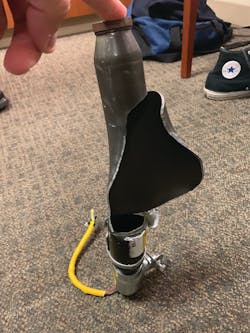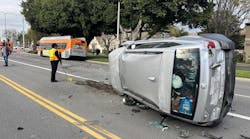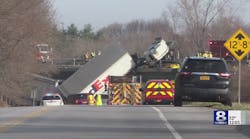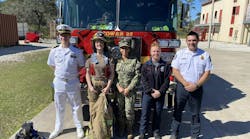Topic: Undeployed airbag hazards
Objective: Review of protocols for responder safety at vehicle-rescue incidents
Task: The rescue team shall develop, improve and/or update procedures for responder safety at vehicle-rescue incidents, with special emphasis on undeployed airbag hazards
Two recent vehicle-rescue incidents that involved entrapment resulted in the injury of responders during the extrication process. These incidents highlight the need for crews to review and refresh their protocols for responder safety at technical rescue scenes. In both cases, undeployed airbag systems caused the injury to the responders.
Airbag traumas
The first case study incident involves a rollover crash of a 2006 Chevrolet Tahoe east of Dallas. The 2006 model-year SUV was manufactured in December 2005. That year, and for almost eight more years, the Tahoe was built with four roof airbags; each roof airbag has a stored-gas inflator that’s pressurized to 9,000 psi. The larger roof airbag on each side was designed to deploy and protect front- and second-row-seat occupants. The second, smaller roof airbag on each side was intended to deploy and protect third-row-seat occupants.
On the day that the crash occured, the Tahoe was occupied by a female driver and her three children, who were seated in the second-row bench seat. The rescue call came in as a single-vehicle, off-the-road, rollover crash with people trapped. Fire/rescue, EMS and police responders found the SUV resting on its roof in a ditch along the side of a rural road; all four occupants were trapped inside. All four doors were jammed, and most of the roof structure was crushed down extensively into the occupant area.
The unusual circumstance in this situation: Only three of the four roof-mounted airbags deployed. Although both roof bags on the driver’s side of the SUV deployed on impact, only the passenger side third-row-seat airbag deployed; the larger front roof airbag remained undeployed.
With responder safety in mind, the fire/rescue procedure is to shutdown 12-volt electrical power. On a 2006 Tahoe, the 12-volt battery is within the engine compartment; however, the battery is on the passenger side near the firewall area. Due to the vehicle’s unstable, roof-resting position and the battery’s location, crews consciously abandoned shutting down the SUV’s 12-volt electrical power: The battery wasn’t realistically accessible. (With all four doors jammed and the roof severely crushed, an interior-access ignition shut-off wasn’t even an option.) So, the extrication took place on a “hot” (read: energized) vehicle.
While crews worked on the driver’s side to stabilize the vehicle and to force open and remove both jammed doors, a fire/rescue member who was on the passenger side sprawled on his belly to partially crawl into the open window of the passenger side rear door. From this vantage point, he was able to access the trapped children in the second-row seat.
While this member was in this position, the fire/rescue member was lying on the undeployed large, roof-mounted airbag. The airbag deployed. Because the SUV was resting on its roof, the airbag actually deployed upward. It inflated into the abdomen and pelvic area of the responder lying across the roofline in the door window opening. The injured responder instantly became a trauma patient and was flown to a trauma center with internal injuries.
Post-crash analysis of the 2006 Chevrolet Tahoe, contact with General Motors officials (General Motors makes Chevrolets) and review of police body-camera footage from the scene failed to determine an exact cause for the airbag deployment. What is known is that the vehicle remained fully energized during the extrication work with the ignition in the “on” position. In addition, the undeployed roof airbag deployed a significant period of time after the rollover occurred.
Fire/rescue ultimately extricated all four trapped occupants via the driver’s side. The doors on the driver’s side of the vehicle were more accessible than were the doors on the passenger side, so strut stabilization work took place there. Both doors were forced open and removed with a power spreader tool. With the hinges fractured, each door’s wiring harness (part of the energized electrical system of the 2006 Tahoe) had to be cut to completely remove each door.
Did cutting the wiring harness short out the electrical system and cause the airbag to inflate? Did the airbag inflate prior to the driver’s side door’s removal, as one rescue officer states is the case? Confirmation one way or the other isn’t possible.“Flapping” the roof
The second case study incident involves a crash-damaged Nissan Pathfinder SUV with the occupant trapped. The specific model year of the SUV wasn't provided except that it fell between late-2005 and 2012. Pathfinders of these model years have separate roof airbags on each side of the vehicle, four in total. Two stored-gas inflators are required, one mounted on the roof rail forward from the B-pillar, and one mounted vertically inside of the C-pillar.
In the process of fire/rescue crews cutting away portions of the roof structure to “flap” the roof, a power cutter sliced into one of the fully pressurized vertically mounted inflators for the roof-mounted airbags. The inflator is positioned on the inside of the C-pillar, beneath an inner plastic trim panel. Unless this trim panel is stripped away, the inflator isn’t visible.
This specific airbag inflator is pressurized to 10,200 psi. When it was cut, the inflator failed violently inside of the vehicle. As a result, five responders were injured. Two of the rescuers suffered concussions. Two others were injured by flying shrapnel. All five suffered hearing-loss issues.
In both cases where responders were injured during the extrication process, ironically it was a roof-mounted airbag or its pressurized inflator that presented a safety hazard and caused responder injury. These recent incidents, from two completely different parts of the country, clearly indicate that all undeployed airbags in crash-damaged vehicles, including roof-mounted types, can and do present safety hazards and do increase the risk of injury to rescue personnel.
Safety protocols implemented by fire/rescue departments should be reviewed and updated as necessary to assure that efforts are made to turn vehicle ignitions off and to shut down electrical systems at the battery(s). If these aren’t possible and the vehicle has to be worked on “hot,” then the risk to responders is increased significantly.
During roof-removal work, undeployed airbag stored-gas inflators must be located, so cutting tools can avoid contacting them. Strip the trim should be the rule. Cutting into a stored-gas inflator that is pressurized to as much as 10,200 psi is very dangerous!







